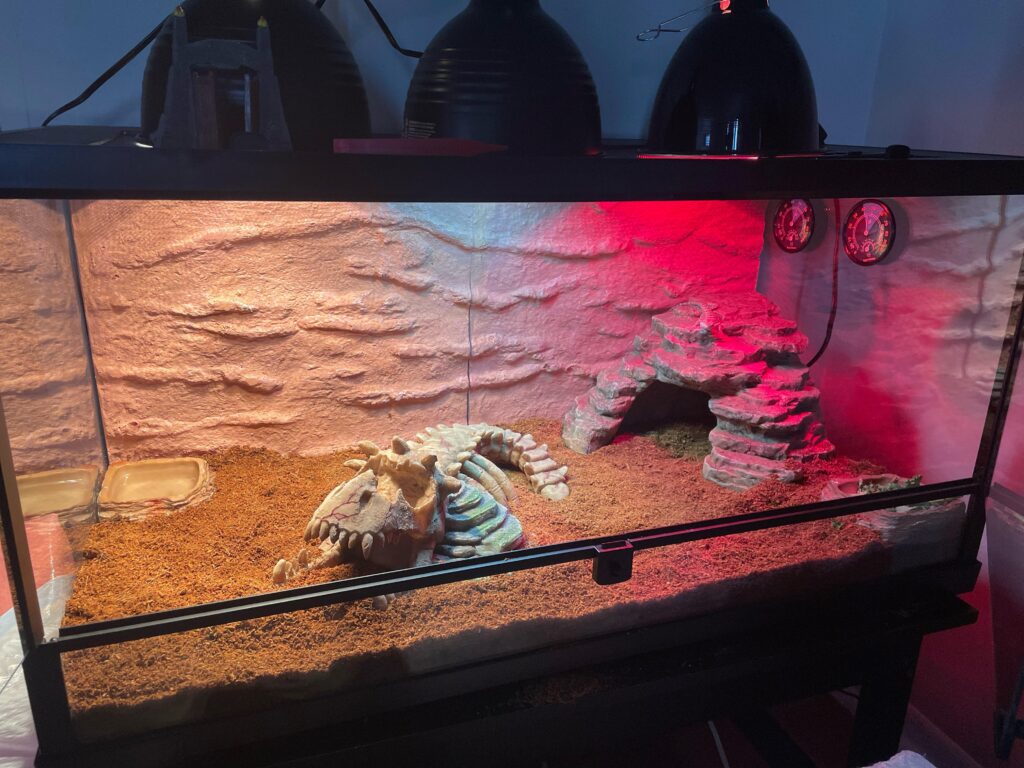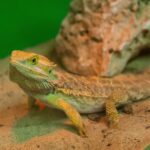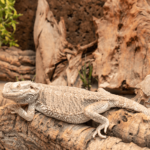There’s no place like home! A bearded dragon’s habitat should be carefully crafted to meet their unique needs and provide them with a healthy and enjoyable environment. Here are some essential elements of the best bearded dragon tank setup.
From the UV lighting, to enclosure size and temperature, creating the perfect space for your scaly friend takes some time and effort but the outcome is well worth it.
We’ll walk you through everything you need to create the perfect environment for your pet lizard. By following these simple tips, you can rest assured that your bearded dragon will be happy and healthy in its new home. Read on to learn more!
Choosing a Tank
Obviously, the first thing to consider when building your bearded dragon setup is a suitable tank. After all, it’s where your beardie will spend the majority of their time. It should provide ample space and a feeling of comfort and security.
Which type of tank should I get?
The best bearded dragon tank setup isn’t contingent any any specific style of tank. There are a variety of materials and shapes out there on the market, you can choose one that works for you. However, there are pros and cons to each material that you’ll want to be aware of.
Glass
A popular choice among new beardie owners, glass tanks tend to be the cheapest and easiest to find. They allow for easy viewing of your pet from all sides and are simple to clean.
However, tanks made only of glass do a poor job of holding in heat. If you plan on using a glass tank, make sure you place it away from drafty windows, radiators, and doors. You will need to be extra vigilant about proper temperature control.
Wood
Wooden enclosures are becoming increasingly popular and are great for holding in heat. Wooden enclosures tend to be more expensive than glass tanks, but are much better suited to providing a stable temperature for your bearding. They also look more attractive and natural, making them a great fit for a living room or bedroom setup.
One thing to keep in mind with wood tanks is that mold can form on them. This can happen if the enclosure is not properly ventilated or if it gets too humid. It’s important to keep an eye out for mold and clean it regularly.
Plastic
These tanks are probably the most advanced options on the market and have improved markedly in recent years. Commonly made of PVC or ABS plastic, they are lightweight, durable and come in a variety of sizes.
It’s typical to see one panel made of a see-through plexiglass with the three other sides made of thicker, opaque material. This allows your pet to have more privacy while still allowing you to view them from the front side.
There are some fancier plastic tank models available for purchase as well. You can find seamless molded terrariums and tanks with built-in lights. If you want to spoil your beardie, these high-end models might be worth an investment eventually, even if they’re not viable with your initial budget.
What size tank should I get?
No matter which tank you choose, make sure it is the appropriate size for your bearded dragon. Babies should be kept in tanks no smaller than 20 gallons, while full-grown adults will need at least 120 gallons
If you’re shopping for tanks for a young bearded dragon, it’s always better to pick a larger tank they they need. This allows your pet to stay settled in one enclosure for a longer period of time, reducing stress.
In addition to size, choose an enclosure that will provide ample vertical space as well. This allows your beardie to climb, basking in the warmth of their UV light fixtures along the way. A good rule of thumb is to chose a tank that is at least as tall as it is wide.
Lighting and Heating for Bearded Dragon Tank Setup
The next most important element of the best bearded dragon tank setup is lighting and heating. These are essential for keeping your pet healthy! Without sufficient light and warmth, including UVA and UVB rays, your beardie won’t be able to process their food and absorb the nutrients they need.
A proper lighting and heating system will be and mounted above the tank and contains a few key parts, namely:
- UVB Lamp, preferably a Mercury Vapor Bulb (as these provide both UVA and UVB rays)
- UVA Heat Lamp/Basking Light
- Humidity Gauge or Hygrometer
- Thermometer
UVA & UVB Lighting
UVB lighting is essential for your bearded dragon’s health. UVB light helps your pet synthesize Vitamin D3, which assists in the absorption of calcium. Without adequate UVB light, your beardie will struggle to process the calcium they consume and can develop metabolic bone disease.
The best type of UVB bulb to choose is a mercury vapor bulb. These provide both UVA and UVB light, creating a more naturalistic environment for your pet. Mercury vapor bulbs tend to be more expensive than other UVB bulbs, but they last much longer and provide a wider spectrum of light.
UVA Heat Lamp/Basking Light
In addition to UVB lighting, your bearded dragon will need a heat lamp or basking light as well. When choosing a basking light, make sure you pick one that is strong enough to warm your pet to the ideal temperatures. Bearded dragons are cold-blooded creatures and need warmth to regulate their body temperature.
Place your heat lamp or basking light at one end of the tank, creating a hot spot for your pet to bask in. You can then monitor the temperatures at different locations throughout the tank.
Creating a Temperature Gradient
When setting up your enclosure, place the basking lamp or heat-producing UVB lamp at one end of the tank, directed at a basking stone or log (just a flat, heat-absorbing surface that will be easy for your beardie to lounge on).
Placing the heat source on one end of the tank creates a temperature gradient, allowing your pet to choose the temperature they’re most comfortable in and adjust as need. Bearded dragons are cold-blooded reptiles, so they use their environment to regulate their temperature.
The hot end of the enclosure (the side where the heat-producing lamp is) should be about 90-100 degrees Fahrenheit, and the cool end should be between 70-80 degrees Fahrenheit.
You can monitor these temperatures with a digital thermometer. Place it at both ends of the tank and watch to make sure they stay in the proper range.
If you find the temperature of either side is too high or low, consider changing the bulb in your lamps to a higher or lower wattage or adjusting the distance between the lamps and your enclosure.
Humidity Gauge/Hygrometer and Thermometer
The next important elements of your bearded dragon setup are a humidity gauge/hygrometer and thermometer. These will help you ensure your pet is living in an environment with the appropriate humidity levels and temperatures. Your beardie needs a specific range of temperature and humidity to stay healthy, so having these items will help you monitor the conditions in your tank.
Humidity levels should stay between 30-40%, while temperatures should be between 75-85°F. Place your hygrometer and thermometer in different locations throughout the tank to make sure the overall temperature and humidity remains within the acceptable range.
Choosing the Right Location
Choosing the perfect location for your pet bearded dragon’s tank or terrarium is a vital part of keeping it healthy and happy.
It should be placed in an area of your home where it will have access to some natural light. However, be careful not to put it in direct sunlight as this can create an overly warm environment and make it difficult for your beardie to regulate its own temperature.
It should also be kept away from any drafty windows, radiators, and frequently open doors, as those pose similar threats to your pet’s ability to regulate its temperature.
It should also be away from direct sources of noise and activity as this can stress out your pet. Remember, beardies and band practice don’t mix!
Finally, check that it is near an outlet so you can easily plug in the numerous lighting and heating elements.
Choosing a Substrate
Deciding on a substrate for your bearded dragon’s home is important to consider.
One of the most popular substrates used are sand or loose soil, since this most closely simulates the bearded dragon’s native habitat.
However, sand can be ingested if it comes into contact with your pet’s food. Ingesting sand can cause severe impaction, so this is not a recommended substrate.
In fact, experts advise against any loose substrate, like gravel, bark, walnut shells, or pine needles.
Instead, opt for a solid substrate such as paper towels, reptile carpet, plastic mesh, or stone tiles. Irregular slabs of slate are a popular choice, as they provide a natural looking flooring and enough traction to keep your scaly friend from sliding around.
The best option, however, is reptile carpet. This substrate has the benefit of being water resistant, easy to clean and softer than tile — making it comfortable for smaller feet! It can be easily removed from an enclosure for convenient cleaning. You can even keep multiple sheets on hand, so that your lizard has a clean and dry area to lounge on, even when you remove one sheet for cleaning.
Create Hiding Spots
Your pet bearded dragon will love having plenty of places to hide among logs, rocks, hammocks and branches.
Creating hiding spots in its terrarium setup can be as simple as arranging logs and rocks together in a way that your dragon can crawl under and feel safe. After all, a bearded dragon’s instinct to hide in tight spaces is a deeply ingrained behavior that helps them feel safe.
You can even purchase special hiding spots, like caves and logs that are specifically designed with dragon-sized hideouts.
Also, adding a hammock for your dragon to curl up under or some safe branches for it to climb over will really spruce up its enclosure and satisfy their need for a sheltering place above the ground.
Food & Water Dishes
When it comes to food and water dishes for your pet bearded dragon, a few simple pieces of equipment (which you probably already have in your kitchen) are sufficient.
Ramekins and small dishes work best for food. The depth of these dishes makes them ideal for keeping your dragon’s food off the substrate and organized in one place.
For water, you can use a shallow bowl or dish as well. A bowl of fresh water is all your pet needs to stay hydrated. And make sure to clean the water dish daily, as it can easily become contaminated if not taken care of properly!
Decorations
To complete your beardie’s home, plants and vines can be added for climbing, plus logs and branches provide basking spots and cover for hiding. These pieces of décor will let your bearded dragon feel like he’s living in his natural habitat! That way, your little reptilian friend will look forward to curling up in his cozy new home.
With just a few simple decorations and plants, you can guarantee your beardie has enough structures to climb and explore.
Of course, make sure any live plants are non-toxic to your reptile friend.
Best Tank Setup for Babies
Once you’ve welcomed a tiny new bearded dragon into your life, creating the best setup for them is essential! Investing in an appropriately-sized terrarium will provide more space and reduce stress during their early development.
For the first couple months of your baby dragon’s life, they’ll be just fine in a smaller home — something like a 20-gallon tank is perfect.
When setting up the terrarium, make sure to provide an appropriate basking area and a cool side. Provide adequate lighting and temperatures on both sides, with the basking side hitting the high end of their comfort range and the cool side on the lower end.
As your baby grows, you’ll need to upgrade their home and provide a larger enclosure for the best bearded tank setup. A 65-75 gallon enclosure will be enough for most juveniles, but full-grown adults will need an even bigger tank to thrive.
You might opt to purchase the large 120-gallon tank right away. This means your little dragon can have plenty of space to explore, and you won’t need to worry about investing in a bigger tank later on!
Summary
Creating the perfect living space for your pet bearded dragon takes a bit of time and thought, but it can be done! With the right products and attention to detail, your best bearded dragon tank setup is easy to create.
Start with a comfortable tank setup that’s large enough for them to move around, add some fun decorations and furniture for enrichment, and don’t forget about food and water dishes. Finally, make sure to invest in proper lighting and temperature control so that your dragon has everything they need to stay healthy and happy.
With these steps, you’ll be able to create an amazing home for your pet beardie!
Happy Reptile Home-Making!






:max_bytes(150000):strip_icc()/13-f9fc54bc64854d20b43e00db91a9cb16.jpg)